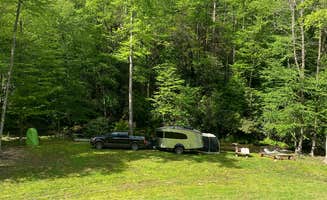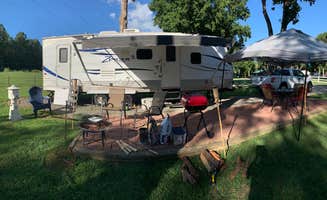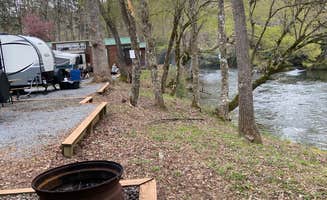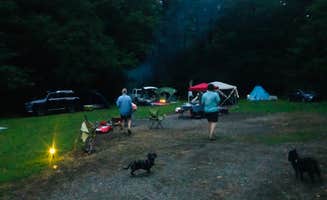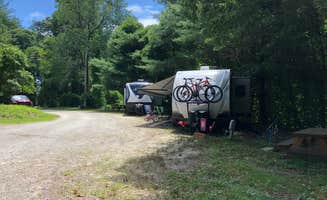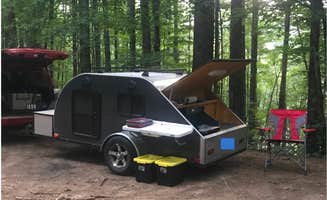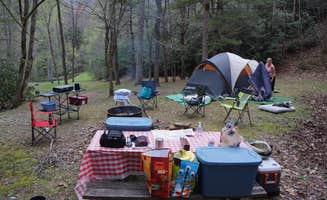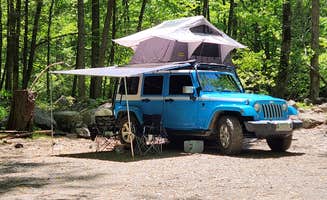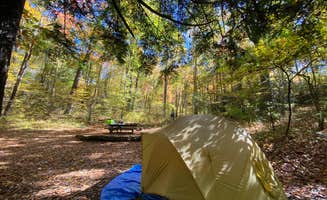The Marble, North Carolina camping area sits in the mountainous terrain of western North Carolina, with elevations ranging from 1,600 to 4,000 feet throughout the surrounding Nantahala National Forest region. Seasonal temperature variations can be significant, with average summer highs around 85°F and winter lows frequently dropping below freezing. Camping sites near Marble offer several creekside options with sites that often fill quickly during peak summer periods.
What to do
Creek fishing opportunities: Multiple camping areas provide direct access to streams and rivers for fishing. At Long Hungry Road Dispersed Campsites, one camper noted, "I stayed at 7 in a van. It had level parking and I could walk down to the bank to fish and have a fire." The sites along the lake are particularly popular for fishing.
Mountain biking trails: The region offers extensive trail systems for mountain biking enthusiasts. At Jackrabbit Mountain, a visitor reported that "The 15 miles of mountain bike trails are absolutely amazing for all skill levels." The campground features a 1.5-mile connector trail to access the main trail system without riding on roads.
Waterfall exploration: Within driving distance of most campgrounds, several waterfalls attract visitors year-round. One camper at Horse Cove mentioned, "We decided to go hike Joyce Kilmore Forest which was a small trek from the campground. Felt like we were camping in a rainforest!" Many of these natural features are accessible via short hikes from main roads.
What campers like
Lake access: Direct water access ranks as a top amenity for many campers. A reviewer at Lake Santeetlah Dispersed shared that "The view was great for watching the sunset. I think there was a pit toilet but we didn't check it out. We only spent one night here but it was great." Many lakeside sites feature trails leading directly to the water.
Privacy between sites: Several campgrounds offer well-spaced sites that create a sense of seclusion. At Horse Cove, a camper observed, "Very quite sites tucked away beside the river, about 5 or 6. Then across the street is about 10 more sites. All nice looking." Similar spacing exists at many of the dispersed sites throughout the region.
Wildlife viewing: The forested settings provide opportunities to observe local wildlife. At Lake Santeelah Dispersed, a camper mentioned, "Deb wants me to mention that she enjoyed watching the cows at the neighboring farm cool off in the river." Bird watching is particularly popular at dawn and dusk at most camping areas.
What you should know
Difficult road access: Many camping areas require navigating challenging roads. As one visitor to Lake Santeelah Dispersed warned, "Warning: the road to get to Lake Santeetlah has endless sharp turns & drop-offs, would not recommend driving this in the dark." Many forest service roads become significantly more difficult after rainfall.
Site reservation systems vary: Some campgrounds require advance booking while others operate first-come, first-served. At Murphy/Peace Valley KOA, campers appreciate that "After the visitor center is closed, a list of available sites are posted and a sign-in Sheet for the site you choose." Most dispersed sites cannot be reserved in advance.
Limited cell service: Connectivity is inconsistent throughout the region. One camper at Lake Santeetlah Dispersed noted, "Cell phone service with Verizon was 1 to 2 bars. Sometimes good others not so." Valleys and densely forested areas typically have the poorest reception.
Tips for camping with families
Kid-friendly water activities: Several campgrounds feature shallow water areas ideal for children. At Vogel State Park Campground, "There is a lake for paddling, swimming, or fishing. For those who like to hike, there is a trail around the lake. One can also use this trail for bike ridding." Many families bring inflatable tubes or kayaks for water play.
Playground facilities: Some established campgrounds offer dedicated play areas. According to a Vogel State Park Campground visitor, "Two separate children's playgrounds exist, not too far from one another. One near a small kids ball field...the other near a very nice volleyball court, permanent corn hole pit and state of the art outdoor exercise machine area."
Wildlife education opportunities: The region provides natural learning experiences for children. At Indian Boundary, one camper shared, "We rented a couple of kayaks to play in the lake with, best idea ever. The campground store manager, Chad, was super nice and very helpful." Rangers often conduct educational programs during summer months at established campgrounds.
Tips from RVers
Site leveling considerations: Many campgrounds have uneven terrain requiring preparation. A visitor to Peachtree Cove RV Park observed, "The sights are level and well spaced, and the creek is charming. The only drawback we've found is the traffic noise, but this is a narrow valley in the Great Smokies so it can't be helped." Bringing leveling blocks is recommended for most sites in the area.
RV height limitations: Some campgrounds have overhead obstacles. At Peachtree Cove RV Park, one RVer warned, "I have a 43' 5th wheel and was assigned to spot 17, a pull through site. Length wise I fit with room to spare. However I am 13'6" in hight and there is a cable/power line over this site and site 16 that hangs a bit too low and my AC unit got aquatinted with it." Always check clearance requirements before booking.
Dump station availability: Not all campgrounds provide full hookups or dump facilities. Jackrabbit Mountain can accommodate larger vehicles but has limitations: "RVers will have to rough it with no hookups, but there is access to a dump station." Calling ahead to confirm facilities is recommended, especially during off-season periods.


